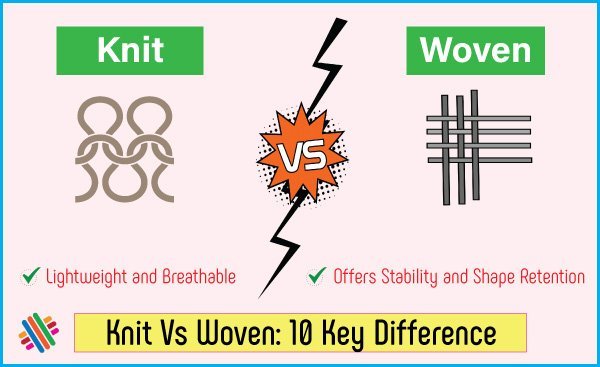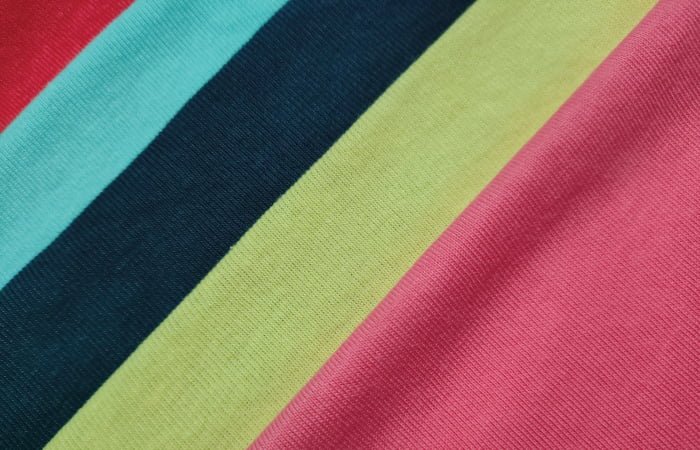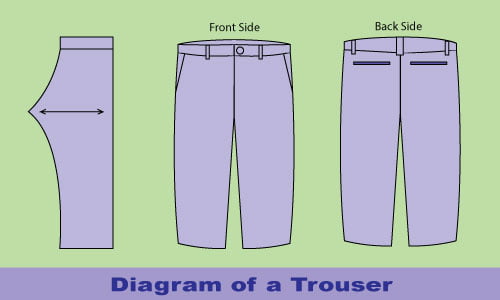Knit Vs Woven: 10 Key Difference
Clothing is an essential article in our personal and social life. And fabric is the primary raw material of clothing. The fabrics can be produced from natural as well as synthetic materials.

There are different types of fabrics available to make dresses. They are woven, knit, non-woven, braided, net or mesh, lace, quilted etc. But the most popular and usable are woven and knit. But here comes the confusion.
When the dressmakers make your dress, it is essential to know the difference. They are two distinct types of textiles which may differ in raw materials, construction, characteristics and end uses.
Understanding Knit Fabric
Knit fabrics are created through a process of interlocking loops of a single yarn. These loops are formed by a knitting machine, resulting in a fabric with a braided or looped appearance. The main characteristics of knit fabrics is their softness, stretchiness and flexibility. When pulled along its width, a knit fabric will stretch significantly, allowing for ease of movement. However, the stretch is slightly limited along its length.

T-shirts, sweaters, polo shirts, socks, and hosiery items are produced from this fabric. The elasticity and comfort make them ideal for different end uses. So casual wear or active wear is produced from these fabrics. Knit fabrics are also lightweight and breathable, making them suitable for warmer weather.
Characteristics of Knit Fabric
Stretch and Flexibility: It shows excellent stretchability and flexibility. It also allows easy movement and a comfortable fit.
Wrinkle Resistance: This fabric is less prone to wrinkling due to its elasticity. It can also quickly recover its shape after crumpling.
Softness: It is known for its softness and comfortable texture. This quality makes it pleasant to wear against the skin.
Versatility: It is used in various projects. It is used in casual clothing and accessories like hats and scarves.
Air permeability: It is several times more air-permeable than woven fabrics. This feature is because the structure is composed of much air space generated due to the interlacement of loops.
Types of Knit Fabric
There are various types of knit fabrics available. Each of these has unique characteristics and end uses. Here are some common types given below:
Single Jersey: Single jersey is the most common type. It has a smooth face side and a looped back side. It is also lightweight, comfortable, and has good stretchability.
Double Jersey: It is also known as interlock. It is thicker and more stable than a single jersey. It has two sets of interlocking loops on both sides. It is reversible and less prone to curling at the edges.
Rib: It has vertical ridges on both sides. It is famous for its excellent stretch and recovery. It is used for cuffs, collars, and waistbands in garments.
Pique: Its pattern looks like a honeycomb or waffle. It is mainly used for polo shirts and sportswear items.
French Terry: Its face side looks like a single jersey, but the back side has loops. It’s mainly used for hoody and casual wear items.
Sweater Knit: It is used to create sweaters and cardigans. It can vary in weight and texture. It is mainly designed to be worn as outerwear.
Jacquard Knit: This features complex patterns or designs woven into a fabric. It can be simple, like stripes, or can produce complex structure.
Pointelle: Small, decorative holes or eyelets in the fabric create a lacy or textured appearance. It is used for lightweight and feminine garments.
Mesh: It has an open and breathable structure. Its appearance is like a grid. It is used in sportswear, activewear and beachwear. It is also used as lining in the outerwear.
Raschel Knit: It is produced by a specific type of knitting machine called Raschel. It has different kinds of patterns and textures. It is mainly used for lace fabrics and netting.
Understanding Woven Fabric
In distinction to knit fabrics, woven fabrics are created by interlacing multiple yarns at right angles. This interlacing creates a crisscross pattern, creating a more structured and durable fabric. These fabrics are commonly made in different types of looms. The looms may be manual or automated.

Woven fabrics offer less stretch and flexibility compared to knits. Commonly, these fabrics stretch along with their width. As lycra or spandex yarn is used in the weft direction. Some fabrics also contain lycra or spandex lengthwise. These are called bi-stretch fabrics.
When it is 100% cotton, it gives minimal stretch along with the length and width direction. This unique character makes woven fabrics ideal for projects that require stability and shape retention. These are used to make tailored garments, formalwear, and home decor items.
Characteristics of Woven Fabric
Durability: Woven fabrics are famous for their tensile and tear strength, which makes them durable. This character makes them suitable for casual wear and utility wear.
Structure and Stability: The tightly interlaced yarn structure gives the fabric more stability. This makes the fabric ideal for garments that require a more tailored and polished look.
Less Stretch: Unlike knit fabrics, woven fabrics offer minimal stretch, providing a more fitted and structured silhouette.
Wrinkle-Prone: Woven fabrics are more prone to wrinkling. So, these require proper care and ironing to maintain a smooth appearance.
Aesthetic property: Woven fabrics present an extensive array of aesthetic properties. These include solid colors, complex patterns, and unique textures. These properties make them the right choice to make creative projects.
Types of Woven Fabric
Many types of woven fabric are available for dress-making. Each has its particular characteristics and end uses. The most common types are:
Plain weave: Plain weave is the first fabric structure made by man on earth. It is formed by interlacing warp and weft yarns in a one-over, one-under pattern. As a result, this fabric becomes solid and durable. It is not very stretchy. Cotton, polyester, linen, etc., fibres are used to make plain weave.
Twill: Twill fabric is marked by its diagonal weaving pattern. This pattern makes the fabric durable and versatile. It is commonly used in jeans, jackets, and chinos.
Chiffon: Chiffon fabric is lightweight and sheer. It is usually used in flowy dresses and blouses.
Denim: Denim is a sturdy and durable woven fabric. It is generally used in jeans and jackets.
Poplin: Poplin fabric has a smooth and crisp texture. It is suitable for dress, shirts and blouses.
Satin: Satin fabric has a smooth and shiny surface. It is often used in formalwear and lingerie items.
Corduroy: It is a fabric with a raised pile surface. Cotton, wool, or polyester and their blends are used to produce corduroy. It is durable and warm. So, it is a good option for fall and winter clothing. It is also soft and comfortable.
Flannel: A soft, napped fabric made from wool, cotton, or synthetic fibres and their blends. It is famous for bedding because it is soft and warm. Flannel sheets and blankets can help you to sleep comfortably in the winter.
Jacquard: Jacquard fabric is a type of woven fabric that uses a particular loom to create intricate designs. Jacquard looms can weave fabrics with complex patterns that would be impossible to make by hand.
Velvet: Velvet fabric is luxurious with a dense pile of evenly cut fibres. It has a distinctive sheen and a smooth, plush texture. Silk, cotton, or synthetic fibres are used to make this fabric. It is used to make evening gowns, suits, jackets, and other formal wear.
Identifying Knit and Woven Fabric
Identifying whether a fabric is knit or woven can be done through a few simple tests. Here are some techniques to distinguish between the two:
Visual Inspection: Look closely at the fabric’s surface. Knit fabrics will have a braided or looped appearance. In comparison, woven fabrics will show a crisscross pattern like a basket.
Stretch Test: Gently pull the fabric along its width. If it stretches significantly, it is likely a knit fabric. Woven fabrics have minimal stretch along their length and width.
Wrinkle Test: Scrunch the fabric in your hand and observe its behaviour. Knit fabrics quickly recover shape with minimal wrinkling. In comparison, woven fabrics are more likely to wrinkle.
Edge Examination: Examine the fabric’s edges. Knit fabrics may have round blobs of starch or glue along the lengthwise edges to prevent curling. In comparison, woven fabrics have selvedges along their width edges.
10 Key Difference Between Knit and Woven Fabric
Hope that you already have some ideas about the knit and woven fabric. Now, we will look at the differences in summary form.
| Topics | Knit | Woven |
| Construction | Are created through a process of interlocking loops of a single or multiple yarn. | Are created by interlacing at least two sets yarns at right angles. |
| Stretch and Elasticity | Have more stretch and elasticity. | Have less stretch and elasticity. |
| Drapability | Have more drapability. | Have a stiffer drape and hold their shape more rigidly. |
| Appearance | Have a textured surface, depending on the specific knit pattern. | Have a flatter appearance. |
| Seam Performance | Suitable for garments that require flexibility. But the seams are not so secured. | Seams are usually more secure. They are commonly used in structured garments. |
| Fabric Selvedge | Have selvedge. | Have no selvedge. |
| Comfort | More comfort due to open spaces. | Less comfort due to tight structure. |
| Dimensional stability | Less dimensional stability. Shrink after washing. | More dimensional stability. Shrink or extend after washing. |
| Crease Resistance | Have good crease resistance. | Have poor crease resistance. |
| End Uses | T-shirt, Polo Shirt, Panty, Bra, Hosiery, Socks, Baby Romper, Tracksuit, Tights etc. | Blazers, Pants, Chinos, Shirts, Skirts, Ties, Jackets etc. |
Conclusion
If you are a sewing lover or garment manufacturer, you should know about the above differences. Knit fabrics are stretchy, flexible, and more comfortable. So, it is suitable for casual wear and active wear. On the other hand, woven fabrics are durable and give a glossier look. So, it is ideal for tailored apparel and formal wear.



